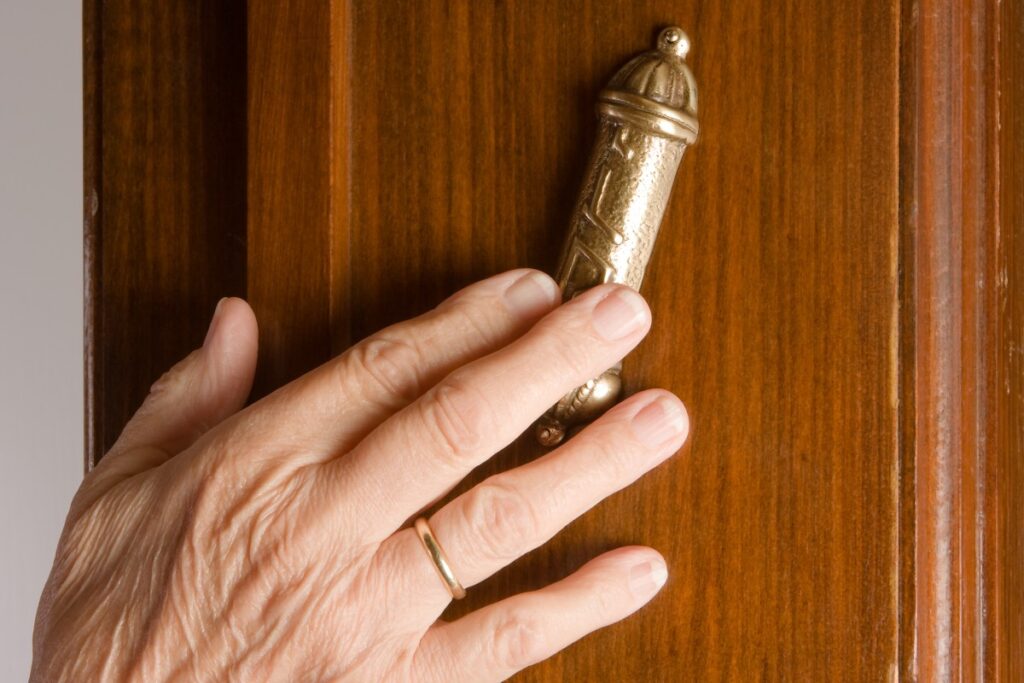
Mezuzah
WHEN YOU'RE WONDERING WHY YOUR NEIGHBORS KEEP HIGH-FIVING THE DOORPOST
Have you ever gone to a friend’s house and noticed a small, usually rectangular-shaped box on the side of the door that wasn’t their doorbell or some other security doodad? If the friend is Jewish, it’s probably their mezuzah. Mezuzah is literally just Hebrew for “doorpost.” But there’s way more than meets the eye…
what's a mezuzah?
IT'S LIKE HAVING A JEWBELONG REMINDER ON YOUR DOOR!
A mezuzah consists of two parts. There’s the holder, which is the part you see on the doorpost, and a small scroll of parchment inside (called a klaf in Hebrew). The scroll has verses from the Torah inscribed on it, including the Shema prayer. For religious Jews, affixing mezuzahs to doorways fulfills a biblical commandment. There are plenty of other reasons to have a mezuzah though. Some people believe that a mezuzah provides special protection for the family that lives inside. It’s also a nice reminder that we have a connection with God/Spirit and/or other Jewish people, and that our homes are special places. It’s a symbol that a sense of Jewish identity and commitment exist in that household, and a way to tell the world, “Hey! I’m Jewish and this is a Jewish home!” (Historically, this may not always have been the best idea, but we still think it’s great to be proud of our Judaism.)
Gifts
Some families give a gift on each night. Seriously though, the idea of eight presents for each member of your family, especially if you have kids can feel a little daunting! Some families give one present on the first night and then treats for the remaining nights. Some families do the opposite and start with tchotchkes that lead up to a bigger gift. Some families plan a special night or vacation together. You get the idea. Do whatever works for you and try not to stress. We hate stress.
Fried foods
Latkes and jelly donuts are tried and true and also delicious but get creative. French fries, onion rings, eggrolls, etc. Especially if the holiday falls on a Friday. (Get it? Fry-day?)
Chocolate coins / gelt
Gelt is Yiddish for money. On Hanukkah, in addition to presents, we’re supposed to give money to charity. Back in the day, before Venmo and Apple Pay, people gave their children coins to give away. Somehow that got translated to handing out those chocolate coins in the awesome fishnet sacks. (Now we’re waiting for the next Hanukkah miracle, which will be a new way to get the foil off the gelt without embedding chocolate under our fingernails.)
EVERYTHING YOU NEED TO KNOW ABOUT THE SCROLL
The mezuzah has a small scroll of parchment inside that is inscribed with two biblical passages, which includes the Shema. The text is a little archaic (we know, shocking!), but the idea is to make sure we remember to teach our children and family about Judaism and that we live a life according to important Jewish values, like Tikkun Olam, and helping people in need.
The scroll is made of handmade parchment from a kosher animal and inscribed in black ink with a special quill pen. The text is written by a specially trained scribe, called a sofer in Hebrew. The scribe isn’t allowed to make a single mistake when writing it out, or he needs to start over. When the sofer is finished, the scroll is rolled up from left to right so that when it is unrolled the first words appear (because Hebrew is read right to left). Then the scroll is ready to insert into the wooden, plastic, or metal holder that is often a little fancy schmancy. If you want to double down, you can also put up a mezuzah on the entrance to each of the interior rooms in your home, just not bathrooms. Mezuzahs are available for sale at Judaica stores and online.